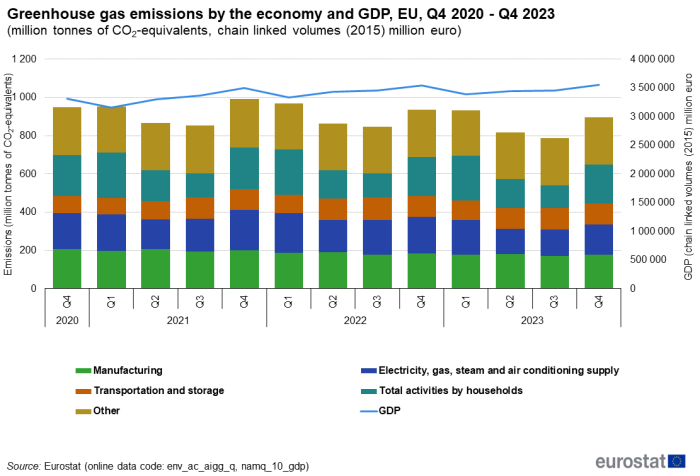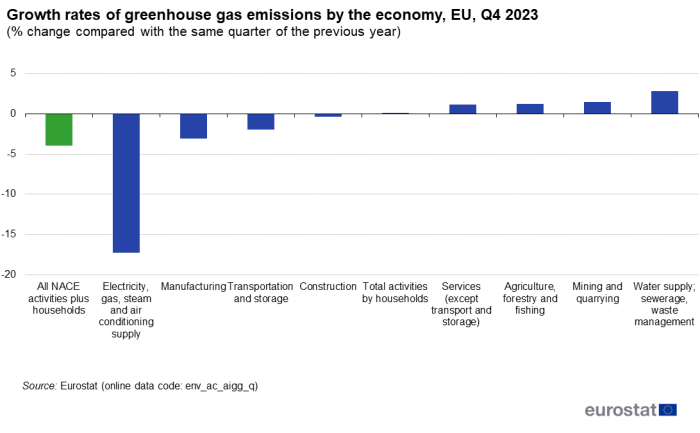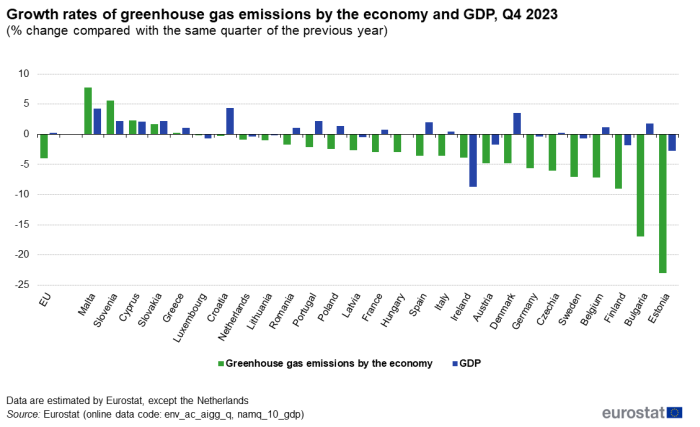Quarterly greenhouse gas emissions in the EU
4th quarter 2023
Data extracted in May 2024
Planned article update: 16 August 2024
Highlights
In the fourth quarter of 2023, EU economy greenhouse gas emissions are estimated at 897 million tonnes of CO2-equivalents, a 4.0 % decrease compared with the same quarter of 2022.
Greenhouse gas emissions - total activities by households
This article is about quarterly emissions of greenhouse gases (GHG emissions) in the European Union (EU) classified by emitting economic activities (industries and households). The GHGs comprise carbon dioxide (CO2), nitrous oxide (N2O), methane (CH4) and fluorinated gases (hydrofluorocarbons (HFC), perfluorocarbons (PFC), sulphur hexafluoride (SF6) and natrium trifluoride (NF3). Eurostat records and publishes these in air emissions accounts (AEA), one of the modules in the European environmental economic accounts (for which the legal basis is Regulation (EU) No 691/2011). AEA are suited for integrated environmental-economic analyses such as calculating emission intensities or 'footprints'.
Full article
Greenhouse gas emissions
In the fourth quarter of 2023, EU economy greenhouse gas emissions were estimated at 897 million tonnes of CO2-equivalents, a 4.0 % decrease compared with the same quarter of 2022 (935 million tonnes of CO2 equivalents).
Emissions by economic activity
Greenhouse gas emissions in the fourth quarter of 2023 are estimated to have decreased by 4.0 % compared with the same quarter in the previous year. In the same period, the EU's gross domestic product (GDP) remained stable, registering a small increase (0.2 % in the fourth quarter of 2023, compared with the same quarter of 2022).

(million tonnes of CO2 equivalents, chain linked volumes (2015) million euro)
Source: Eurostat (env_ac_aigg_q), (namq_10_gdp)
In the fourth quarter of 2023 the economic sectors contributing the most to the total greenhouse gas emissions were households (22.9 %), manufacturing (19.9 %) and electricity and gas supply (17.7 %). The grouping 'other' is composed of the following sectors: agriculture, forestry and fishing; mining and quarrying; construction; water supply, sewerage, waste management and services (except transportation and storage) (see Figure 1).

(% change compared with the same quarter of the previous year)
Source: Eurostat (env_ac_aigg_q)
Compared with the fourth quarter of 2022, emissions decreased in four out of nine economic sectors. The economic sectors responsible for the most reductions compared with the fourth quarter of 2022 were electricity and gas supply (-17.2 %) and manufacturing (-3.1 %). Emissions by households remained almost stable. The sector of water supply, sewerage and air conditioning supply showed the biggest increase of emissions (+2.8 %) (see Figure 2).
Greenhouse gas emissions across EU Member States
In the fourth quarter of 2023, greenhouse gas emissions are estimated to have decreased in 22 EU countries, when compared with the fourth quarter of 2022. The largest reductions in greenhouse gases are estimated for Estonia (-23.0 %), Bulgaria (-17.0 %) and Finland (-9.0 %). Out of the 22 EU countries that are estimated to have decreased their emissions, 10 also recorded a decline in their GDP (Estonia, Finland, Sweden, Germany, Austria, Ireland, Latvia, Lithuania, The Netherlands and Luxembourg). Hungary maintained the GDP at the same level while decreasing emissions. The other 11 EU countries (Bulgaria, Belgium, Czechia, Denmark, Italy, Spain, France, Poland, Portugal, Romania and Croatia) are estimated to have managed to decrease emissions while increasing their GDP.

Source: Eurostat (env_ac_aigg_q), (namq_10_gdp)
Increases in emissions are estimated for Malta (+7.7 %), Slovenia (+5.6 %), Cyprus (+2.3 %), Slovakia (1.7 %) and Greece (+0.3 %). Simultaneously, all 5 recorded a GDP increase: Malta (+4.3 %), Slovenia (+2.2 %), Cyprus (+2.1 %), Slovakia (+2.2 %) and Greece (+1.1 %) (see Figure 3).
Source data for tables and graphs
Data sources
Quarterly data are estimated by Eurostat applying the methods described in the methodological note on Eurostat's Estimates of Quarterly Greenhouse Gas Emissions Accounts. The quarterly estimates are based on sub-annual activity data and annual air emissions accounts (AEA).
In AEA, the emissions data are organised by economic activity, using the NACE classification. This arrangement makes it possible to have an integrated environmental-economic analysis to supplement national accounts. The scope encompasses production by all businesses resident in the country, including those operating ships, aircraft and other transportation equipment in other countries.
Air emissions accounts also include households as consumers. Their emissions are accounted for whenever household consumption is directly responsible for environmental pressures. For example, emissions from a privately owned car are accounted under households, whereas cars owned by transport businesses (such as taxis) are accounted under transportation and storage.
The following groupings of economic activities are used in this article:
- agriculture, forestry and fishing — NACE Rev. 2 Section A;
- mining and quarrying — NACE Rev. 2 Section B;
- manufacturing — NACE Rev. 2 Section C;
- electricity, gas, steam and air conditioning supply — NACE Rev. 2 Section D;
- water supply, sewerage, waste management — NACE Rev. 2 Section E;
- construction - NACE Rev. 2 Section F;
- transportation and storage — NACE Rev. 2 Section H;
- services (except transportation and storage) — NACE Rev. 2 Sections G to U minus H;
- households — households as consumers;
- other - sum of agriculture, forestry and fishing; mining and quarrying; construction; water supply, sewerage, waste management and services (except transportation and storage)
In addition, Eurostat disseminates greenhouse gas emissions classified by technical processes. These are recorded in GHG emission inventories, including data for international climate policies. Furthermore, Eurostat estimates and disseminates 'footprints' which are greenhouse gas emissions classified by final products that are demanded by households or government, or that are invested in or exported.
Each greenhouse gas has a different capacity to cause global warming, depending on its radiative properties, molecular weight and the length of time it remains in the atmosphere. The global warming potential (GWP) of each gas is defined in relation to a given weight of carbon dioxide for a set time period (for the purpose of the Kyoto Protocol a period of 100 years). GWPs are used to convert emissions of greenhouse gases to a relative measure (known as carbon dioxide equivalents: CO2-equivalents). The weighting factors currently used are as defined in the IPCC Fifth Assessment Report: carbon dioxide = 1, methane = 28, nitrous oxide = 265 and sulphur hexafluoride = 23 500; hydrofluorocarbons and perfluorocarbons comprise a large number of different gases that have different GWPs.
Context
The data obtained from air emissions accounts may subsequently feed into political decision-making, underpinning policies that target both continued economic growth and sustainable development, including the European Commission's latest initiative, the European Green Deal. Improving the timeliness of disseminating greenhouse gas emissions is one objective of the 'action plan for the Green Deal'. Air emissions accounts measure the interplay between the economy and the environment with respect to air emissions, in order to assess whether current production and consumption activities are on a sustainable path of development. Measuring sustainable development is a complex undertaking as it has to incorporate economic, social and environmental indicators.
Direct access to
- Greenhouse gas emission statistics - air emissions accounts
- Quarterly national accounts - GDP and employment
- Greenhouse gas emission statistics - emission inventories
- Greenhouse gas emission statistics - carbon footprints
- Environmental accounts - establishing the links between the environment and the economy
- National accounts and GDP
- Air pollution statistics - air emissions accounts
- Air emissions accounts (env_air_aa)
- env_ac_aigg_q
- env_ac_ainah_r2
- env_ac_aibrid_r2
- env_ac_aeint_r2